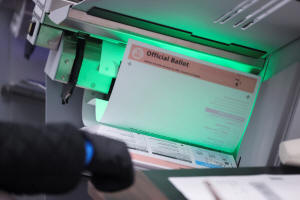Explainer: Why recounts rarely change the results of U.S. elections
 Send a link to a friend
Send a link to a friend
 [November 11, 2020]
By Brad Heath [November 11, 2020]
By Brad Heath
WASHINGTON (Reuters) - U.S. President
Donald Trump hopes a recount of votes will help keep President-elect Joe
Biden out of the White House, but as common as recounts may be,
especially for state and local candidates, only three in the last two
decades have changed the result and none for a presidential election.
Here's how recounts work and the impact they have had:
WHAT IS A RECOUNT?
In a recount, authorities repeat the process of tallying up votes. They
are a relatively common feature of U.S. elections, though rare in
presidential contests.
“Recounts are routine. Run-of-the-mill,” said William & Mary Law School
professor Rebecca Green. She said they usually show the first count to
be fairly accurate, though small discrepancies, often caused by
differing judgments about how to count ballots marked by hand and other
issues, are not unusual.
States handle recounts differently, but the process mostly comes down to
re-tallying the votes.

In Georgia, the latest tally puts Biden ahead of Trump by about 12,000
votes, 49.5% to 49.3%, with 99% of the expected ballots counted.
Voters there who showed up in person used a new touchscreen voting
system that produced paper ballots that were fed into a scanner and
counted. People who voted absentee used the same ballots that went
through similar scanners.
When the machines could not determine which candidate a voter had
selected, a bipartisan group of election officials reviewed the ballot
to decide whether or how it should be counted. If Trump requests a
recount, authorities in Georgia would repeat that process.
Separately, Trump’s campaign has claimed, without much proof, that it
has found evidence of ballots being cast by people who died or had moved
away, and that its volunteers had been prevented from scrutinizing
ballot counting as closely as they wanted. Recounts will not address
those issues, which have to be fought out in separate legal proceedings.
The process can take weeks, but some states also set a deadline for
getting it done.
CAN TRUMP GET A RECOUNT?
Every state sets its own threshold for when to do a recount. Some
require one whenever an election is especially close. In Pennsylvania,
one of the states pivotal to Biden's victory, a recount is required if
the margin between the winning candidate and the runner-up is less than
0.5% of the votes cast in the election. As of noon ET (1700 GMT) on
Tuesday Biden was leading Trump there by about 0.67% of nearly 6.8
million votes counted. Voters in an election district can separately
petition their county to recount votes there and the law does not set a
threshold for when one should occur.
Other states like Georgia and Wisconsin allow a losing candidate to
force a recount but do not require one. Georgia allows candidates to
seek a recount if the margin is less than 0.5%; Wisconsin allows one if
it is less than 1%. As of noon ET on Tuesday, Biden was leading Trump in
both states, but the count was close enough that Trump’s campaign would
be able to seek a recount.
[to top of second column]
|

A person counts postal ballots following the 2020 U.S. presidential
election, in Downey, near Los Angeles, California, U.S., November 5,
2020. REUTERS/Lucy Nicholson

Typically, candidates make those requests after a state has
certified its final vote tally, which has yet to happen.
DOES IT MAKE A DIFFERENCE?
Recounts rarely upset the results of an election. When they have, it
has been in cases in which only a few hundred votes separated the
top two candidates.
A study last year by the non-partisan group Fair Vote concluded that
states had conducted 31 statewide recounts between 2000 and 2019,
and that the outcome changed in only three of them. That happened in
a governor’s race in Washington state in 2004 and in a state
auditor's race in Vermont in 2006.
A recount also decided the result of a U.S. Senate race in Minnesota
in 2008. Before the recount, the incumbent senator, Norm Coleman,
was ahead by 215 votes; when it was over, his opponent, Al Franken,
won by 225. But delayed by legal proceedings the contest took so
long that the state’s U.S. Senate seat stayed empty for six months.
More often, in a recount the winner won by a tiny bit more. On
average, they shifted the outcome by 0.024%, Fair Vote found - a
vastly smaller margin than Trump would need to overtake Biden in any
of the battleground states where he was losing by narrow margins.
Wisconsin, where Trump’s campaign has said he will seek a recount
this year, recounted the presidential votes when Trump was elected
in 2016. Green Party candidate Jill Stein, who won about 1% of the
vote, sought the recount. The process added 131 votes to Trump's
tally.
Last week, the state’s former Republican governor, Scott Walker,
cautioned that Trump faces a “high hurdle” in trying to upset the
results of an election in which he now trails Biden in the state by
more than 20,000 votes.

The most famous presidential recount was in Florida in 2000, when
George W. Bush was 1,784 votes ahead of Al Gore in a state that
would determine which of them would be president. After a recount
and litigation that went to the U.S. Supreme Court, Florida
ultimately declared that Bush had won by 537 votes.
(Reporting by Brad Heath, editing by Ross Colvin and Howard Goller)
[© 2020 Thomson Reuters. All rights
reserved.] Copyright 2020 Reuters. All rights reserved. This material may not be published,
broadcast, rewritten or redistributed.
Thompson Reuters is solely responsible for this content. |